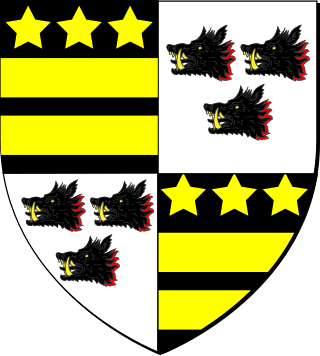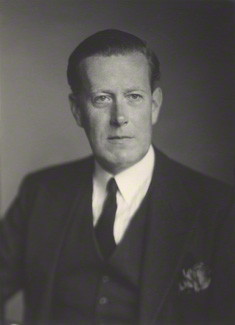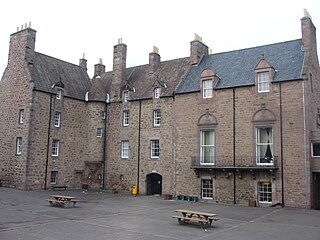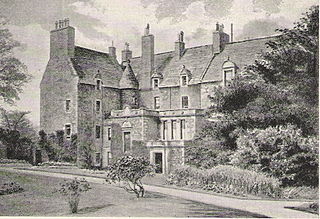
Earl of Galloway is a title in the Peerage of Scotland. It was created in 1623 for Alexander Stewart, 1st Lord Garlies, with remainder to his heirs male bearing the name and arms of Stewart. He had already been created Lord Garlies in the Peerage of Scotland in 1607, with remainder to the heirs male of his body succeeding to the estates of Garlies. This branch of the Stewart family were distant relatives of the Stewart Kings of Scotland.

Viscount Torrington is a title in the Peerage of Great Britain. It was created in 1721 for the statesman Sir George Byng, 1st Baronet, along with the subsidiary title Baron Byng, of Southill in the County of Bedford, also in the Peerage of Great Britain. He had already been created a baronet, of Wrotham in the County of Kent, in the Baronetage of Great Britain in 1715. His eldest son, the second Viscount, represented Plymouth and Bedfordshire in the House of Commons and later served as Captain of the Yeomen of the Guard from 1746 to 1747. His younger brother, the third Viscount, was a major-general in the Army. His grandson, the sixth Viscount, was a vice-admiral in the Royal Navy. His son, the seventh Viscount, served as Governor of Ceylon between 1847 and 1850.

Earl of Egmont was a title in the Peerage of Ireland, created in 1733 for John Perceval, 1st Viscount Perceval. It became extinct with the death of the twelfth earl in 2011.

Earl of Chichester is a title that has been created three times, twice in the Peerage of England and once in the Peerage of the United Kingdom. The current title was created in the Peerage of the United Kingdom in 1801 for Thomas Pelham, 2nd Baron Pelham of Stanmer.
Lord Belhaven and Stenton, of the County of Haddington, is a Lordship of Parliament in the Peerage of Scotland. It was created in 1647 for Sir John Hamilton, 2nd Baronet, with remainder to his heirs male.

Earl of Lonsdale is a title that has been created twice in British history, firstly in the Peerage of Great Britain in 1784, and then in the Peerage of the United Kingdom in 1807, both times for members of the Lowther family.

Baron Carbery, of Carbery in the County of Cork, is a title in the Peerage of Ireland. It was created in 1715 for George Evans, with remainder to the heirs male of his father and namesake George Evans, a supporter of William and Mary during the Glorious Revolution, who had earlier declined the offer of a peerage. After his elevation to the peerage, Lord Carbery represented Westbury in the House of Commons. He was succeeded by his eldest son, the second Baron. He also sat as Member of Parliament for Westbury. His grandson, the fourth Baron, briefly represented Rutland in Parliament. He was succeeded by his uncle, the fifth Baron. On his death, the line of the eldest son of the first Baron failed. He was succeeded by his first cousin once removed, the sixth Baron, who had previously succeeded his father as second Baronet, of Castle Freke. Lord Carbery sat in the House of Lords as an Irish Representative Peer from 1824 to 1845. His nephew, the eighth Baron, was an Irish Representative Peer from 1891 to 1894. As of 2014 the titles are held by the latter's great-great-grandson, the twelfth Baron, who succeeded his father in 2012.

Baron Bellew, of Barmeath in the County of Louth, is a title in the Peerage of Ireland. It was created on 17 July 1848 for Sir Patrick Bellew, 7th Baronet, who had previously represented Louth in the House of Commons as a Whig and also served as Lord Lieutenant of County Louth. His grandson, the third Baron, was also Lord Lieutenant of County Louth and sat in the House of Lords as an Irish Representative Peer from 1904 to 1911. He was succeeded by his younger brother, the fourth Baron. He was an Irish Representative Peer from 1914 to 1931. In 1881 Lord Bellew assumed by Royal licence the additional surname of Bryan under the terms of the will of his maternal uncle Colonel George Bryan. However, he is the only one of the Barons to have held this surname. On his death the titles passed to his nephew, the fifth Baron, and then to his younger brother, the sixth Baron. As of 2018 the titles are held by the latter's grandson, the eighth Baron, who succeeded in 2010.

Baron Hazlerigg, of Noseley in the County of Leicester, is a title in the Peerage of the United Kingdom. It was created in 1945 for Sir Arthur Hazlerigg, 13th Baronet. He had previously served as Lord Lieutenant of Leicestershire. As of 2023 the title is held by his great-grandson, the fourth Baron, who succeeded his father in 2022.

Baron Glanusk, of Glanusk Park in the County of Brecknock, is a title in the Peerage of the United Kingdom. It was created in 1899 for Sir Joseph Bailey, 2nd Baronet, who had earlier represented Herefordshire and Hereford in the House of Commons as a Conservative. Both his son, the second Baron, and grandson, the third Baron, served as Lord Lieutenant of Brecknockshire. The latter was succeeded by his first cousin, the fourth Baron. He was the son of the Hon. Herbert Crawshay Bailey, fourth son of the first Baron. As of 2010 the titles are held by his son, the fifth Baron, who succeeded in 1997.
Baron Denham, of Weston Underwood in the County of Buckingham, is a title in the Peerage of the United Kingdom. It was created in 1937 for Sir George Bowyer, 1st Baronet, a Conservative politician who had earlier represented Buckingham in the House of Commons. He had already been created a baronet, of Weston Underwood, in 1933. Bowyer was a great-great-great-grandson of Sir William Bowyer, 3rd Baronet, of Denham Court. As of 2017 the titles are held by his second but only surviving son, the 2nd Baron, who succeeded in 1948. In 1950 he also succeeded his distant relative in the Bowyer baronetcy, of Denham Court. Like his father, the 2nd Baron Denham was a Conservative politician and one of the ninety elected hereditary peers that remain in the House of Lords after the passing of the House of Lords Act 1999.
Baron Wrottesley, of Wrottesley in the County of Stafford, is a title in the Peerage of the United Kingdom. It was created on 11 July 1838 for Sir John Wrottesley, 9th Baronet. He was a Major-General in the Army and also represented Lichfield, Staffordshire and Staffordshire South in House of Commons. The Wrottesley family's original patronymic was 'de Verdun', which meant that the creation of the title Baron Wrottesley represented the third barony created by a branch of the de Verdun family in England. The other two were established by Theobald de Verdun, 1st Baron Verdun of Alton Castle and Sir John de Verdon, 1st Baron Verdon, lord of Brixworth in Northamptonshire and Bressingham in Norfolk.

Baron Poltimore, of Poltimore in the County of Devon, is a title in the Peerage of the United Kingdom. It was created in 1831 for Sir George Bampfylde, 6th Baronet. His son, the second Baron, held office as Treasurer of the Household from 1872 to 1874 in the first Liberal administration of William Ewart Gladstone.

Victor Alexander George Anthony Warrender, 1st Baron Bruntisfield, known as Sir Victor Warrender, Bt, between 1917 and 1942, was a British Conservative politician. He held minor political offices between 1928 and 1945, notably as Parliamentary and Financial Secretary to the Admiralty from 1940 to 1945 in Winston Churchill's war-time coalition government. In 1942 he was ennobled as Baron Bruntisfield. He is also said to be the first politician Margaret Thatcher looked up to before beginning her career in politics.

The Purves, later Purves-Hume-Campbell, later Home-Purves-Hume-Campbell Baronetcy, of Purves Hall in the County of Berwick, was a title in the Baronetage of Nova Scotia. It was created on 25 July 1665 for William Purves. The fourth baronet married Lady Anne, daughter of Alexander Hume-Campbell, 2nd Earl of Marchmont. Their grandson, the sixth baronet, assumed the additional surnames of Hume and Campbell. The latter's son, the seventh baronet, assumed the additional surname of Home. He sat as member of parliament for Berwickshire. The title became extinct on the death of the eighth Baronet in 1960.
Sir George Warrender of Lochend, 4th Baronet, PC, FRS, FRSE was a Scottish politician. In 1799, he succeeded to his father's baronetcy. Due to his lifestyle, he was nicknamed Sir Gorge Provender.
The Buchan-Hepburn Baronetcy, of Smeaton-Hepburn in the County of Haddington, is a title in the Baronetage of the United Kingdom. It was created on 6 May 1815 for George Buchan-Hepburn. He was a Judge of the Admiralty Court from 1790 to 1791 and a Baron of the Exchequer for Scotland from 1791 to 1814. Born George Buchan, he assumed by Royal licence the additional surname of Hepburn in 1764, which was that of his maternal grandfather. His grandson, the third Baronet, represented Haddington in the House of Commons from 1838 to 1847. His son, the fourth Baronet, was a deputy lieutenant of Haddingtonshire. On the death of his grandson, the sixth Baronet, in 1992, the line of the eldest son of the second Baronet failed. The late Baronet, stepfather of the Duchess of Northumberland, was succeeded by his third cousin, the seventh and holder of the title. He was succeeded by his grandson in 2022. The family surname is pronounced "Bukkan-Hebburn".
There have been four baronetcies created for people with the surname Innes, three in the Baronetage of Nova Scotia and one in the Baronetage of the United Kingdom. Three of the creations are extant as of 2010.

Sir Patrick Warrender of Lochend, 3rd Baronet was a Scottish soldier and politician.

Sir George Warrender, 1st Baronet of Bruntsfield and Lochend, Edinburgh was a Scottish merchant and politician who sat in the House of Commons from 1715 to 1722.














